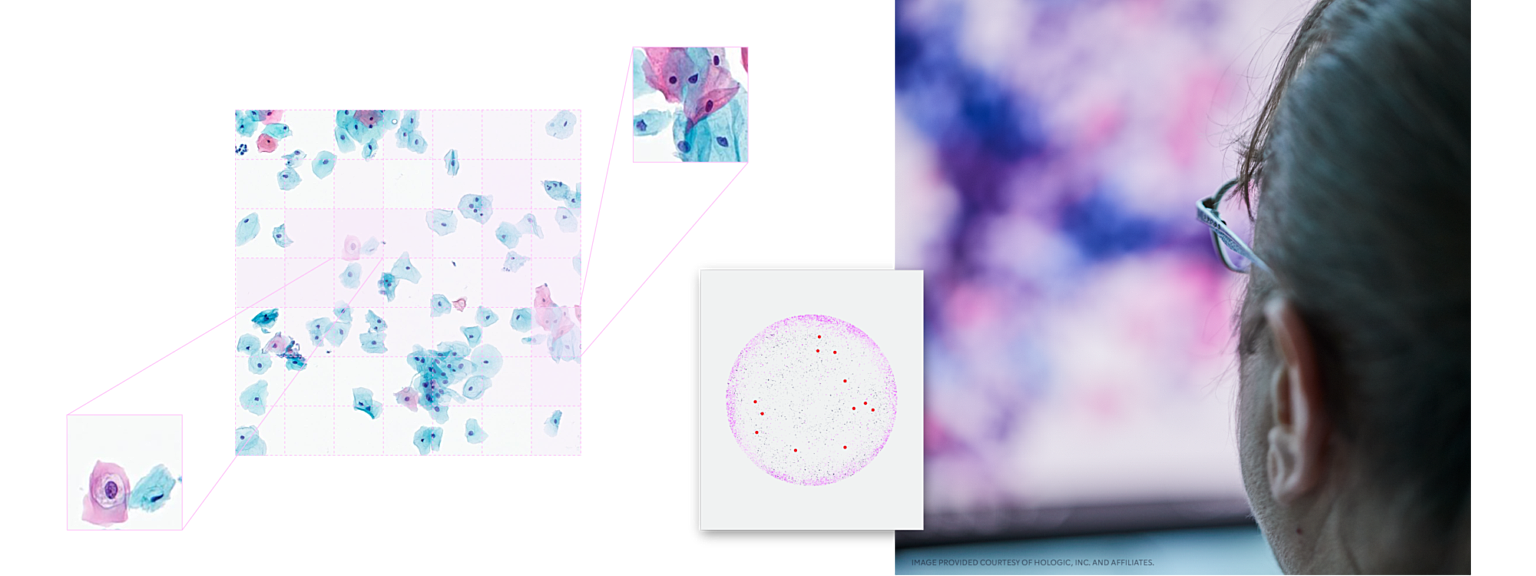Using AI to advance cervical cancer screening for all
OVERVIEW
Intelligent healthcare solutions save lives. Hologic is driven to innovate cervical cancer screening methods to guide better treatment decisions for patients and ensure no more women die from this preventable disease. Bringing the power of intelligent solutions, Slalom Build was engaged by Hologic to advance the development of their digital cytology platform, which is designed to improve cytology lab efficiency, help promote earlier diagnosis and treatment, and advance efforts to eradicate cervical cancer everywhere.
SCOPE
Intelligent Products, Artificial Intelligence, Machine Learning, Data Security, MLOps, On-prem to Cloud
TECHNOLOGY
Google Cloud Storage, Genius Digital Diagnostics, GitHub, Jupyter Notebook, Kubeflow, Deep Learning VM Image, NVIDIA Tensor Core GPUs
There’s no eradication without access to care
Cervical cancer is the fourth most common cancer found in women globally.
Fortunately, medical advancements have introduced reliable screening methods that can catch cancer or even pre-cancer early and improve patient outcomes. So why are so many women still dying from the disease?
For many patients, human papillomavirus (HPV) vaccines and cervical cancer screening with Pap and HPV testing are widely available and routine. For others, preventive care visits may be few and far between. Disparities in care exist. Not all women around the world have access to the same technology and resources that allow for routine screening. If women go unscreened, the ones with cervical cancer may not be identified until long after the disease develops—when it could be too late.
In fact, of the estimated 342,000 deaths from cervical cancer in 2020, about 90 percent of cases occurred in developing countries.


Accurate and efficient cervical cancer screening
Leading women’s health innovator and medical technology company Hologic, which develops many diagnostic solutions, has worked for decades on improving cervical cancer screening— both quality and access—worldwide. Reliable screening and prevention methodologies for cervical cancer have made significant progress in the fight against this disease, but Hologic wants to keep improving them so one day it can help prevent the disease entirely.
To do so means advancing solutions that address today’s lab challenges—such as how clinical laboratories are experiencing significant labor shortages as well as pressure to achieve more with constrained resources. In fact, compared to 1995, the number of cytologists entering the field in the U.S. decreased by 65%.
“The introduction of the Pap test in the 1940s is credited with a substantial decline in cervical cancer incidence,” explains Michael Quick, Vice President of Research and Development and Innovation at Hologic. “But technological advancements like this only go so far if there aren’t the medical professionals to identify the disease, or if patients aren’t receiving this lifesaving test in the first place.”
Moreover, the act of examining slides for signs of pre-cancerous or cancerous cells can be arduous and time consuming for lab professionals.
With the hope of serving patients everywhere and combat barriers to care, Hologic came to Slalom Build to help advance their current solution and create a proof-of-concept (POC) algorithm that has the potential to help save more lives. By leveraging the latest in intelligent products, they wanted to accomplish something new in the industry: further advance cervical cytology analysis to look at the entire patient slide to aid in disease detection.
“The opportunity to impact our mothers and daughters is just something I couldn’t pass up.”
— Nima Niakan, Growth Partner, Slalom Build

Searching for needles in a haystack of haystacks
Slalom Build brought together a team of data engineers, software architects, solution owners, platform engineers, and quality engineers to help develop a prototype machine learning (ML) algorithm. This advancement could enable Hologic’s future digital cytology iterations to autonomously detect cancerous or pre-cancerous cells in patient samples—to provide cytologists even more insight.
This meant designing, from scratch, neural networks that can perform image-based classification. In other words, teaching bots to look at extremely complicated images cell-by-cell, recognize certain characteristics, and then identify relevant cells to help complement the work of an expert cytologist.
When analyzing patient cells under a microscope, cytologists typically zoom in on single areas of the sample, one at a time. With AI-assisted review, this is what the algorithm is doing. It rapidly analyzes all cells on the entire cell spot to identify potential abnormalities. Imagine analyzing a picture of human cells, pixel by pixel, in an image that is over 100,000 pixels wide. It’s like looking for a needle in 100,000 haystacks.

To train the model, Slalom Build and Hologic worked with more than 50,000 images, each roughly 20GB. The engineers created protocols to slice and dice the images so they could be processed faster. And it all had to be done with patient privacy and data security baked in from the start. Working with the Google Cloud Platform gave the teams an edge on massive HIPAA-compliant data storage and ML research, which helped us establish an infrastructure capable of processing thousands of these images in seconds.
So, we not only needed to train a machine to complement the work of a highly trained human cytologist—but we also had to grow and evolve its ability to scan the entire image in a standardized, efficient manner and render the slide-level probability of a diagnostic category.

Continued advancement in digital cytology
In initial tests, the proof-of-concept algorithm exceeded expectations. The POC algorithm autonomously determined slide-level classification of pap test images with ~70% relative sensitivity compared to human review.
We proved that the POC artificial intelligence (AI) algorithm has the potential to learn to replicate what a human expert sees and complement their abilities. And as the algorithm improves over time, the results can only get better.

“AI could make cervical cancer screening so much faster while not losing any accuracy,” affirms Ashley Jarosz, Hologic Lab Supervisor. “I'm absolutely inspired that this work could further improve patient outcomes.”
Michael Quick is excited about what this means for the future of patient care, “The technology that we've developed at Hologic with Genius Digital Diagnostics and Genius Cervical AI could propel the World Health Organization’s goal of eradicating cervical cancer in our generation. This POC project is evidence of the technology’s potential to provide lab professionals even greater insight into patient care in the future.”
And in the meantime, lifesaving cervical cancer screening can become more readily available to people everywhere.
Next Up